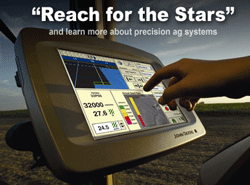 2008 OSU Precision Agriculture Data Management, Analysis and Decision Making Workshop
2008 OSU Precision Agriculture Data Management, Analysis and Decision Making Workshop
This workshop is about making use of “Best Management Technologies” for use in Precision Agriculture. You will learn how to integrate tools such as GPS, GIS, sensor technologies and other geodata for use in making management decisions.
Several topics covered in the workshop include:
– Yield monitoring and mapping
– Soil mapping and sampling
– Soil fertility mapping
– Field Management Zones
– Variable Rate Applications and Mapping
– GPS and navigation system selection
– Environmental planning
– On-Farm Research
A workshop binder and CD will contain resources and software for attendees to take home. The class is taught one day a week for a 3-week period. When you register you are registering for 3 days of classes.
Class size is limited to 19 people at each location. Registration is on a first-come first-serve basis so register early!
Who Should Participate?
This workshop is designed for those who have no to limited experience using precision agriculture technologies. It is designed for agricultural producers, consultants, and cooperatives.
What You Will Take Home
– How to manage and use data for map creation for yields, soils, fertility, variable rate applications, and other data sources.
– Knowledge of what GPS equipment, GIS and mapping software and services are needed for specific applications
– Ability to sort out field spatial variability
– Develop field management zones and working with multiple years of data
– Create profit maps to assess field productivity levels
– Field record keeping techniques for effective data collection
– Ability to create maps for reports and planning
– Strategies for on-farm research techniques to see cause and effect relationship between farm practices and precision agriculture technologies.
– Strategies for environmental stewardship and techniques for effective conservation program implementation.
Sponsored By
This program has been made possible by collaborative efforts involving the Ohio Geospatial Extension Program, OSU Extension Agriculture and Natural Resources, and The Ohio State University Precision Agriculture Team.
CCA CEU credits applied for. Workshop includes resource materials, lunch, and breaks. If you have special needs that need accommodation, please contact us 1 week prior to workshop. Cancellation and substitution conditions apply. You may receive a refund only if we receive notice within 1 week in advance of workshop start date.
For more information contact:
Nathan Watermeier
OSU Extension
(614) 688-3442
E-mail: watermeier.2@osu.edu
 We are getting back in touch with all the ASA/John Deere “Reach for the Stars” winners this year to see how the system worked for them and just how their crop year has been.
We are getting back in touch with all the ASA/John Deere “Reach for the Stars” winners this year to see how the system worked for them and just how their crop year has been. Colin Dutenhoffer (4:00 min mp3)
Colin Dutenhoffer (4:00 min mp3)
 Here’s another use for aerial imagery – helping ranchers decide how many cows they can support per acre, as well as how much carbon rangeland plants store.
Here’s another use for aerial imagery – helping ranchers decide how many cows they can support per acre, as well as how much carbon rangeland plants store.  We’re going to publish a regular post called, “Precision Agriculture in the News” to point you to stories we find. That’s part of what will make Precision.AgWired.com a good aggregator of information for you.
We’re going to publish a regular post called, “Precision Agriculture in the News” to point you to stories we find. That’s part of what will make Precision.AgWired.com a good aggregator of information for you. This past week I’ve been attending an International Federation of Agricultural Journalists Congress in Japan. On one of our stops we saw precision agriculture on display in a rice paddy! This is in development now at the
This past week I’ve been attending an International Federation of Agricultural Journalists Congress in Japan. On one of our stops we saw precision agriculture on display in a rice paddy! This is in development now at the  Dr. Dale Rollins, Extension wildlife specialist at San Angelo, said most people, even those with a global positioning system in their car or pocket, don’t fully understand the technology.
Dr. Dale Rollins, Extension wildlife specialist at San Angelo, said most people, even those with a global positioning system in their car or pocket, don’t fully understand the technology.  As they mention often, 1 in 3 jobs in Nebraska is related to agriculture. It is a stat that catches the attention of incoming students and that is reflected in the school’s enrollment figures released this week.
As they mention often, 1 in 3 jobs in Nebraska is related to agriculture. It is a stat that catches the attention of incoming students and that is reflected in the school’s enrollment figures released this week. 2008 OSU Precision Agriculture Data Management, Analysis and Decision Making Workshop
2008 OSU Precision Agriculture Data Management, Analysis and Decision Making Workshop They also had a chance to see the biggest and most technologically advanced machines in the world zip through corn during the show. And what modern farm show would be complete without precision farming exhibits? At HHD, new tractors equipped with autosteer and similar equipment strutted their stuff in the familiar Ride ‘n Drive area and visitors had a chance to visit with John Deere representatives as well as take a hands-free test drive.
They also had a chance to see the biggest and most technologically advanced machines in the world zip through corn during the show. And what modern farm show would be complete without precision farming exhibits? At HHD, new tractors equipped with autosteer and similar equipment strutted their stuff in the familiar Ride ‘n Drive area and visitors had a chance to visit with John Deere representatives as well as take a hands-free test drive.  See the entire
See the entire